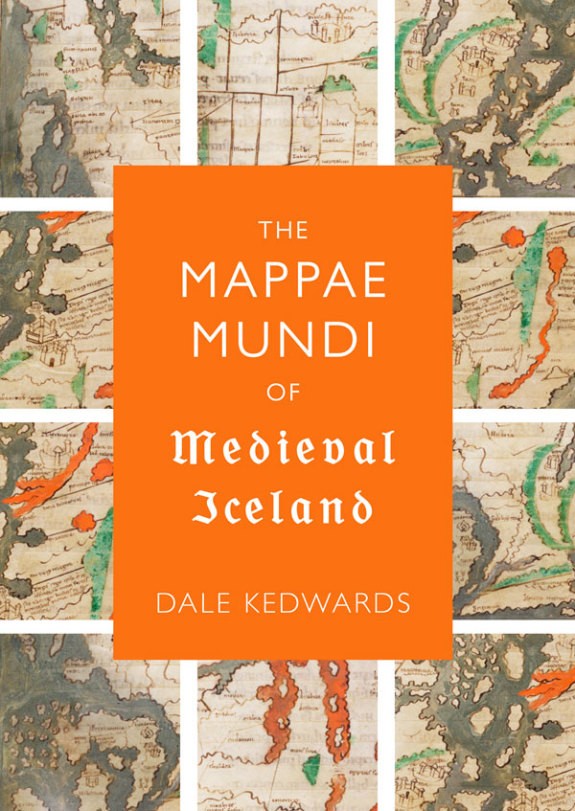
The Mappae Mundi of Medieval Iceland
Dale Kedwards (former postdoc at CML and now postdoc at the University of Iceland ) writes about his new publication "The Mappae Mundi of Medieval Iceland"
NEW PUBLICATION: The Mappae Mundi of Medieval Iceland
In the prologue to the Prose Edda, an Icelandic ars poetica composed in the early thirteenth century, the Icelandic literary magnate Snorri Sturluson describes the origins of Icelandic language and poetry. According to Snorri, the Norse gods – Oðinn, Þórr, Loki – were not true ‘divinities’, but exceptionally talented people who had come to Northern Europe from Anatolia and Central Eurasia. Óðinn, a king among the Æsir who possessed knowledge of the future, knew that he would find posterity in the world’s northern regions, and so travels from Central Eurasia into Northern Europe, establishing himself, according to Ynglingasaga, on the Danish island of Fyn. The gods’ transcontinental migrations were, according to Snorri, evidenced by language. He derives Æsir (singular Ás) from Ásiamenn (‘Asian people’), and claims that the subgroup of divinities called the Vanir originated in a region on the banks of the River Tanais (Don) called Tanaheimr, or, in ancient times, Vanaheimr.
Through the stories they told about the origins of their language and literary culture, Icelanders situated themselves in a wide world. Óðinn settles on Fyn, which, as home of one half of the Centre for Medieval Literature, continues to be the epicentre for conversations about theorising medieval literature at a European, or even Eurasian scale. It was here that I had the happy experience of writing the greater part of my book, The Mappae Mundi of Medieval Iceland (Cambridge: D.S. Brewer, 2020).
The Icelandic mappae mundi (‘world maps’), drawn between c. 1225 and c. 1400, are contemporary with the rise of Iceland’s vernacular literary culture, and, as such, provide important insights into the Icelanders' expansive geographical awareness in the age of saga writing. Icelanders used the map medium to think, as we saw in the prologue to Snorra Edda, about their place in the wider world. Although they belong to cartographic genres in near pan-European circulation – the hemispherical world map, the zonal map, and the tripartite or T-O map – the Icelandic environment in which these maps were copied assigned its own meaning to them, as Icelandic thinkers used them, uniquely, to think about their place in the world and history.
Map historians have tended to be more interested in the mappa than the mundus, examining maps primarily alongside other maps, and only partially reckoning with the social and cultural worlds through which they moved. My book begins and ends with the maps, but widens the lens to look more widely at their related literatures, including Geoffrey of Monmouth’s History of the Kings of Britain and its commentaries, the astronomical writings of the English-born Parisian scholar Johannes de Sacrobosco, the writings of the Parisian teacher Hugh of St Victor, and works of Icelandic literature including Heimskringla, Snorra Edda, Landnámabók, and Hungrvaka. By bringing these literatures to bear on the maps, we see how they grant visual expression to Icelanders’ ideas about their history, their ancestry and social origins, and the distinctiveness of their social institutions. I reveal more completely how these images engage matters of Icelandic self-perception and imagining in the thirteenth and fourteenth centuries, an interesting time for the development of Icelandic literature in the vernacular, as well as for the intense social dynamics that marked Iceland’s transition from Commonwealth to a possession of the Norwegian Crown. These maps, and the colourful range of astronomical treatises, planetary diagrams, and historical writings that accompany them in their manuscript books, reach out and relate to more literatures and histories than we have previously known.
The book contains colour facsimiles, texts, and translations of the Icelandic mappae mundi, with chapter commentaries that situate the maps in their various literary, historical and material contexts. It reveals the connectedness, reciprocity, and intense creativity that characterises Icelandic engagement with other European literary and intellectual cultures, and its final form owes much to the environment at the CML .